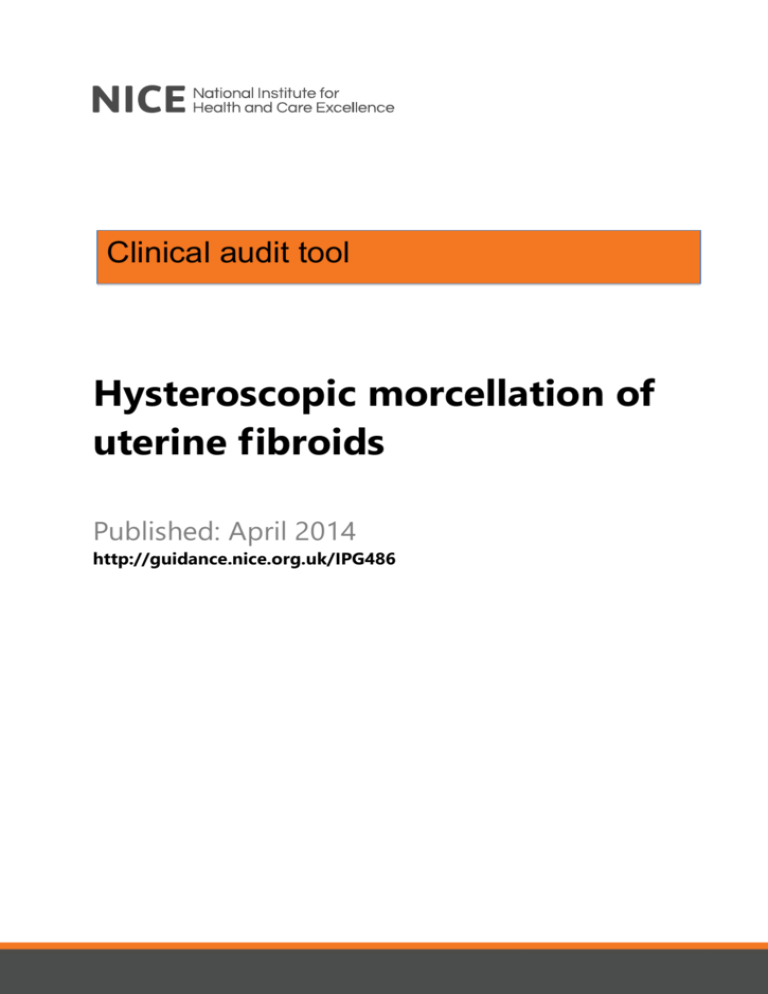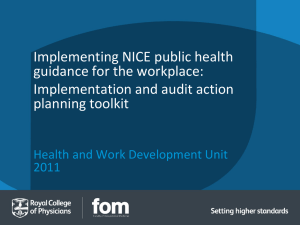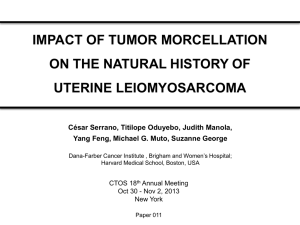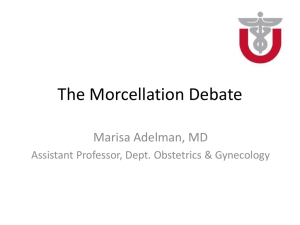
Clinical audit tool
Hysteroscopic morcellation of
uterine fibroids
Published: April 2014
http://guidance.nice.org.uk/IPG486
This clinical audit tool accompanies the interventional procedure: Hysteroscopic morcellation
of uterine fibroids
Issue date: 2014
This document is a support tool for clinical audit based on the NICE guidance. It is not NICE
guidance.
Acknowledgements
NICE would like to thank the following people who have contributed to the development of
this clinical audit tool and have agreed to be acknowledged:
Samuel Marcus, Consultant Obstetrics and Gynaecologist, Queen Elizabeth Hospital, South
London Healthcare NHS Trust
Soe Nyunt Aung, ST6 in Community Sexual and Reproductive Healthcare, Leeds
Community Healthcare NHS Trust
Jacqueline Parry, Clinical Audit Facilitator
National Institute for Health and Care Excellence
Level 1A, City Tower, Piccadilly Plaza, Manchester M1 4BT; www.nice.org.uk
© National Institute for Health and Care Excellence, 2014. All rights reserved. This material may be
freely reproduced for educational and not-for-profit purposes. No reproduction by or for commercial
organisations, or for commercial purposes, is allowed without the express written permission of
NICE.
Clinical audit tool: Hysteroscopic morcellation of uterine fibroids (2014)
2
Hysteroscopic morcellation of uterine fibroids clinical audit tool
NICE has recommended that hysteroscopic morcellation of uterine fibroids should only be
used with special arrangements for audit. This means that clinicians undertaking the
procedure should audit and review the clinical outcomes of all patients. Audit data should be
reviewed at appropriate intervals and practice should be changed if the results suggest the
need to do so.
To help clinicians audit and review clinical outcomes NICE has produced this clinical audit
tool, which is for use at local discretion. It contains clinical audit criteria and a data collection
form which can be used in its current form or amended to suit local preferences.
A data collection form should be completed for each patient. Demographic information can
be completed if this information is essential to the project.
Patient identifiable information should never be recorded on the data collection form and
clinical audit data could be pseudonymised. For example, a secure file containing the audit
IDs linked to the patient identifiable items of information could be held in a different location
to the clinical audit data. This will enable the data to be linked to the patients again but it will
mean that clinical audit data alone will not identify individuals. For further details refer to the
Healthcare Quality Improvement Partnership (HQIP) Information governance guide for
clinical audit.
To ensure that any valuable insight regarding the consequences of this procedure is shared
among clinicians, serious or previously unrecognised patient safety incidents should be
documented and information submitted to the National Reporting and Learning System
(NRLS).
For further information about clinical audit, clinicians should refer to a clinical audit
professional within their own organisation or the HQIP website.
To ask a question about this clinical audit tool, or to provide feedback to help inform the
development of future tools, email auditsupport@nice.org.uk.
Clinical audit tool: Hysteroscopic morcellation of uterine fibroids (2014)
3
Audit criteria for hysteroscopic morcellation of uterine fibroids clinical
audit
Criterion 1
The percentage of patients undergoing hysteroscopic morcellation of uterine
fibroids who have had any of the following clinical outcomes:
operating time
fluid deficit
size and number of fibroid morcellated
failed procedure (such as failure to dilate the cervix)
symptom relief
- menorrhagia
- pain
- infertility
improvement of quality of life
other.
Exceptions
None
Standard
Outcomes from published literature should be considered when reviewing audit
data, such as those set out in the guidance.
Data items
See data collection tool, data items 4 to 9, 10 to 15 and 22 to 27.
Definitions
NICE does not recommend a particular Quality of Life tool. The tool used
should be recorded in the data collection sheet.
Criterion 2
The percentage of patients undergoing hysteroscopic morcellation of uterine
fibroids who have had any of the following adverse events:
uterine perforation
bowel perforation
fluid deficit needing intervention
bleeding needing intervention
device issues
other.
Exceptions
None
Standard
Adverse events from published literature should be considered when reviewing
audit data, such as those set out in the guidance.
Data items
See data collection tool, data items 16 to 21, 28 and 29.
Hysteroscopic morcellation of uterine fibroids (2014)
4
Definitions
Adverse event grades
0:
No adverse event
I:
Any deviation from the normal postoperative course without the need
for pharmacological treatment or surgical, endoscopic and radiological
interventions.
II:
IVa:
IVb:
Requiring pharmacological treatment with drugs other than such
allowed for grade I complications. Blood transfusions and local
parenteral nutrition are also included.
Requiring surgical, endoscopic or radiological intervention
Intervention not under general anaesthesia.
Intervention under general anaesthesia
Life threatening complication (including CNS complications) requiring
IC/ICU-management
Single organ dysfunction (including dialysis)
Multi organ dysfunction
V:
Death of a patient
III:
IIIa:
IIIb:
IV:
Suffix If the patient suffers from a complication at the same time of discharge,
‘d’:
the suffix “d” (for ‘disability’) is added to the respective grade of
complication. This label indicates the need for a follow-up to fully
evaluate the complication.
For further definition of these grades please visit www.surgicalcomplication.info
Criterion 3
The percentage of patients undergoing hysteroscopic morcellation of uterine
fibroids who have:
been told that there are uncertainties about the procedure’s safety and
efficacy
received written information explaining that there are uncertainties about
the procedure’s safety and efficacy
given written consent to treatment.
Exceptions
If the patient is unable to understand information and/or give consent to
treatment.
Standard
100%
Data items
See data collection tool, data items 1 to 3.
Definitions
NICE recommends its Information for the public. This document is written to
help patients who have been offered this procedure (and their families or
carers) to decide whether to agree to it or not.
Hysteroscopic morcellation of uterine fibroids (2014)
5
Data collection form for clinical audit of hysteroscopic morcellation of
uterine fibroids
Audit ID:
Age:
Ethnicity:
The audit ID should be an anonymous code. Patient identifiable information should never be recorded.
Data
item
Data
Tick/complete box as indicated
Consent
1
2
3
Has the patient been told that there are
uncertainties about the procedure’s safety and
efficacy?
Yes
No
Has the patient received written information
explaining that there are uncertainties about the
procedure’s safety and efficacy?
Yes
No
Has the patient given written consent to treatment?
Yes
No
Date of procedure and baseline data
4
Date of procedure
Date:
5
Quality of life
Measure(s) used and score:
6
Menorrhagia
7
Pain
8
Infertility
9
Other
Clinical outcomes – intraprocedural
10
Date of assessment
11
Operating time:
12
Fluid deficit:
Date:
Yes
No
Detail:
13
Size and number of fibroids morcellated:
14
Failed procedure (such as failure to dilate the
cervix)
15
Other clinical outcome
Yes
No
Detail:
Grade:
Hysteroscopic morcellation of uterine fibroids (2014)
6
Adverse events – up to 30 days
16
Uterine perforation
17
Bowel perforation
Grade:
Grade:
18
Fluid deficit needing intervention
Grade:
19
Bleeding needing intervention
Grade:
20
Device issues
Grade:
21
Other adverse event
Detail:
Grade:
Clinical outcomes – all subsequent follow-up (copy section as needed)
22
Date of follow-up
23
Improved quality of life
Date:
Yes
No
Detail:
24
Menorrhagia?
Yes
No
Detail:
25
Pain?
Yes
No
Detail:
26
Infertility?
Yes
No
Detail:
27
Other clinical outcome
Detail:
Adverse events – all subsequent follow-up (copy section as needed)
28
Device issues
Grade:
29
Other adverse event
Detail:
Grade:
Adverse event grades
0:
I:
No adverse event
Any deviation from the normal postoperative course without the need for pharmacological treatment
or surgical, endoscopic and radiological interventions.
II:
Requiring pharmacological treatment with drugs other than such allowed for grade I complications.
Blood transfusions and local parenteral nutrition are also included.
III:
Requiring surgical, endoscopic or radiological intervention
IIIa:
Intervention not under general anaesthesia.
IIIb:
Intervention under general anaesthesia
IV:
Life threatening complication (including CNS complications) requiring IC/ICU-management
IVa:
Single organ dysfunction (including dialysis)
IVb:
Multi organ dysfunction
V:
Death of a patient
Suffix ‘d’: If the patient suffers from a complication at the same time of discharge, the suffix “d” (for ‘disability’) is
added to the respective grade of complication. This label indicates the need for a follow-up to fully
evaluate the complication.
For further definition of these grades please visit www.surgicalcomplication.info
Hysteroscopic morcellation of uterine fibroids (2014)
7










